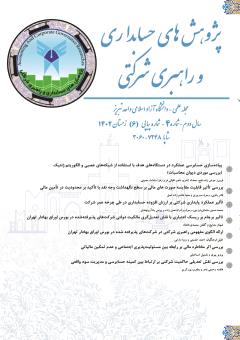پیادهسازی حسابرسی عملکرد در دستگاههای هدف با استفاده از شبکههای عصبی و الگوریتم ژنتیک (بررسی موردی دیوان محاسبات)
محورهای موضوعی : حسابداری مالیفریبرز عوض زاده فتح 1 , محدثه تندرو 2 , ناصر اقبالی فر 3 , زهرا سادات حسینی 4
1 - استادیار گروه حسابداری واحد گچساران، دانشگاه آزاد اسلامی، گچساران، ایران
2 - دانشجوی دکتری حسابداری، واحد یاسوج، دانشگاه آزاد اسلامی، یاسوج، ایران
3 - مربی گروه حسابداری، واحد یاسوج، دانشگاه آزاد اسلامی، یاسوج، ایران
4 - استادیار گروه حسابداری، واحد یاسوج، دانشگاه آزاد اسلامی، یاسوج، ایران
کلید واژه: حسابرسی عملکرد, دیوان محاسبات, شبکه عصبی, الگوریتم ژنتیک, گرگ خاکستری.,
چکیده مقاله :
یکی از چالشهای عمده حسابرسی عملکرد شناسایی عوامل موثر بر پیاده سازی صحیح و میزان و نحوه اثرگذاری این عوامل بر بهبود فرآیند عملیاتی دستگاههای اجرایی است. بر این اساس هدف تحقیق حاضر پیادهسازی حسابرسی عملکرد در دیوان محاسبات کشور است. این پژوهش در قلمرو پژوهشهای کاربردی است. تحقیق حاضر دارای دو جامعه است. جامعه اول متخصصان و خبرگان (حسابرسان سازمان حسابرسی، حسابرسان دیوان محاسبات و حسابداران و مدیران مالی دیوان محاسبات) و جامعه دوم کارمندان و مدیران دیوان محاسبات کشوری در بازه زمانی تحقیق است. در جامعه اول از تکنیک گلوله برفی جهت تعیین حجم نمونه بهره گرفته شد و بر اساس اصل اشباع اطلاعاتی 14 نفر انتخاب شدند. در نمونه دوم از روش نمونهگیری در دسترس با استفاده از فرمول کوکران اقدام به تعیین حجم نمونه که 315 نفر به عنوان نمونه انتخاب شدند. بر اساس مبانی نظری 8 عامل موثر بر پیادهسازی حسابرسی عملکرد در دیوان محاسبات کشور شناسایی شدند؛ بر اساس رویکرد دلفی- فازی نوع 3 عوامل شناسایی شده مورد تأیید قرار گرفتند. سپس 18 رویکرد شبکه عصبی، ژنتیک و الگوهای ابتکاری و فرابتکاری جهت بررسی نحوه اثرگذاری عوامل موثر بر پیادهسازی حسابرسی عملکرد در دیوان محاسبات کشور مورد بررسی قرار گرفت. بر اساس نتایج رویکرد گرگ خاکستری نسبت به سایر روشها از دقت بالاتری برخوردار بود. بر اساس نتایج روش گرگ خاکستری متغیرهای زیرساختها (3440/0)؛ کارایی (1849/0)؛ اثربخشی (1134/0)؛ صرفه اقتصادی (2947/0)؛ فرهنگسازی (3657/0)؛ نیروی انسانی متخصص (5984/0)؛ عملکرد سازمان (4609/0)؛ مدیریت و رهبری (6804/0) بر پیاده سازی حسابرسی عملکرد تأثیر مثبت و معنادار دارند.
One of the major challenges of the performance audit is identifying the factors affecting the correct implementation and how these factors affect the operational process improvement of executive bodies. The current research aims to implement the performance audit in the Iran Audit Court. This research is applied. The present research has two communities. The first group comprises specialists and experts (audit organization auditors, Audit Court auditors, Audit Court accountants, and financial managers). The second community consists of National Audit Court employees and managers during the research period. In the first community, the snowball technique was used to determine the sample size, and 14 people were selected based on the principle of information saturation. In the second community, the convenience sampling method was used to determine the sample size using Cochran's formula (n=315). Eight effective factors in implementing performance audit in the National Audit Court were identified based on the theoretical basis. Regarding the Delphi-phase type 3 approach, the identified factors were confirmed. Then, 18 neural network, genetics, heuristic, and meta-heuristic approaches were investigated to investigate the effect of the effective factors on the implementation of performance audits in the National Audit Court. The gray wolf approach was more accurate than other methods. According to the results of the gray wolf method, infrastructure variables (0.3440); efficiency (0.1849); effectiveness (0.1134); economic efficiency (0.2947); cultivation (0.3657); specialist human resources (0.5984); organization performance (0.4609); management and leadership (0.6804) have a positive and significant effect on the implementation of performance audit.


